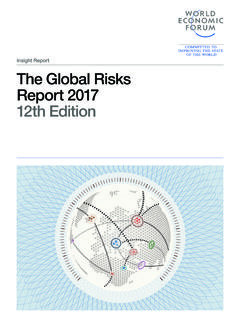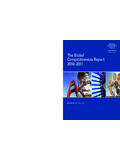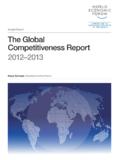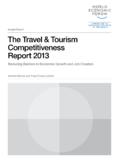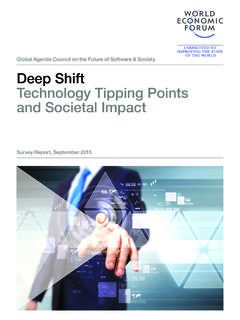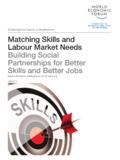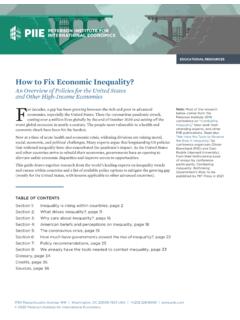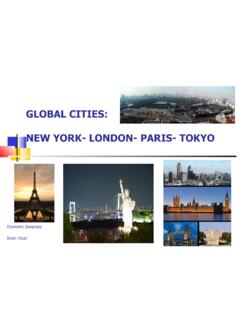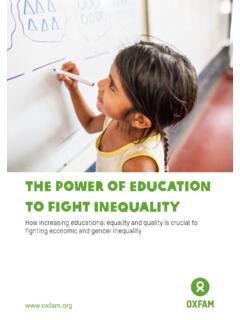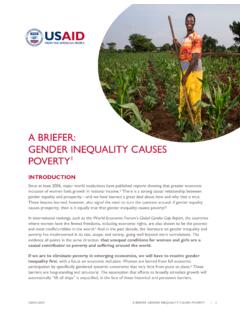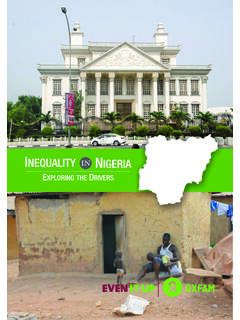Transcription of Insight Report The Global Human Capital Report 2017
1 Insight ReportThe Global Human Capital Report 2 017 Preparing people for the future of workInsight ReportThe Global Human Capital Report 2 017 Preparing people for the future of work World Economic Forum 2017 All rights reserved. No part of this publication may be reproduced or transmitted in any form or by any means, including photocopying and recording, or by any information storage and retrieval 978-1-944835-10-1 TERMS OF USE AND DISCLAIMERThe Global Human Capital Report 2017 (herein: Report ) presents information and data that were compiled and/or collected by the World Economic Forum (all information and data referred herein as Data ).
2 Data in this Report is subject to change without terms country and nation as used in this Report do not in all cases refer to a territorial entity that is a state as understood by international law and practice. The term covers well-defined, geographically self-contained economic areas that may not be states but for which statistical data are maintained on a separate and independent the World Economic Forum takes every reasonable step to ensure that the Data thus compiled and/or collected is accurately reflected in this Report , the World Economic Forum, its agents, officers, and employees: (i) provide the Data as is, as available and without warranty of any kind, either express or implied, including, without limitation, warranties of merchantability, fitness for a particular purpose and non-infringement; (ii) make no representations, express or implied, as to the accuracy of the Data contained in this Report or its suitability for any particular purpose.
3 (iii) accept no liability for any use of the said Data or reliance placed on it, in particular, for any interpretation, decisions, or actions based on the Data in this parties may have ownership interests in some of the Data contained in this Report . The World Economic Forum in no way represents or warrants that it owns or controls all rights in all Data, and the World Economic Forum will not be liable to users for any claims brought against users by third parties in connection with their use of any World Economic Forum, its agents, officers, and employees do not endorse or in any respect warrant any third-party products or services by virtue of any Data, material.
4 Or content referred to or included in this shall not infringe upon the integrity of the Data and in particular shall refrain from any act of alteration of the Data that intentionally affects its nature or accuracy. If the Data is materially transformed by the user, this must be stated explicitly along with the required source Data compiled by parties other than the World Economic Forum, users must refer to these parties terms of use, in particular concerning the attribution, distribution, and reproduction of the Data for which the World Economic Forum is the source (herein World Economic Forum ) is distributed or reproduced, it must appear accurately and be attributed to the World Economic Forum.
5 This source attribution requirement is attached to any use of Data, whether obtained directly from the World Economic Forum or from a who make World Economic Forum Data available to other users through any type of distribution or download environment agree to make reasonable efforts to communicate and promote compliance by their end users with these who intend to sell World Economic Forum Data as part of a database or as a standalone product must first obtain the permission from the World Economic Forum Global Human Capital Report 2017 v Preface vii Key Findings Part 1: Measuring Global Human Capital 3 The Global Human Capital Index 2017 4 Measuring Global Human Capital 4 Underlying Concepts 5 Subindexes 6 Index Construction 7 Global Human Capital Index Results 7 Global Overview 10 To p Te n 11 Results By Region 16 Results By Income Group 17 Results By Subindex 19 Thematic Analysis 19 Capacity 22 Deployment 25 Development 33 Know-How 34 Conclusion 36 Notes 36 References 39 Appendix A: Regional and Income Group Classifications, 2017 41 Appendix B: Technical Notes Part 2.
6 Country Profiles 49 User s Guide: Exploring the Global Human Capital Index Data 57 List of Countries 58 Country Profiles 189 System Initiative Partners 191 AcknowledgmentsContentsvThe Global Human Capital Report 2017 PrefaceKLAUS SCHWABF ounder and Executive Chairman, World Economic ForumThe world is endowed with a vast wealth of Human talent. The ingenuity and creativity at our collective disposal provides us with the means not only to address the great challenges of our time but also, critically, to build a future that is more inclusive and Human centric. All too often however, Human potential is not realized, held back either by inequality or an unrealistic and outdated faith on the part of policymakers that investment in small sub sections of highly skilled labour alone can drive sustainable, inclusive Global Human Capital Report 2017 proposes a new benchmark for leaders to build the workforces of the future.
7 The approach it advocates, based on the principle that all people deserve an equal opportunity to develop their talents, provides leaders with the means and the tools to navigate the changes we are already witnessing from the current wave of automation and successfully navigate the transition to the Fourth Industrial the Report , the Global Human Capital Index provides a means of measuring the quantifiable elements of the world s talent potential so that greater attention can be focused on delivering it. By measuring countries talent resources holistically according to individuals ability to acquire, develop and deploy skills throughout their working life rather than simply during the formative years, we hope to foster a true revolution in educational systems where education is geared to meeting the needs of the future this transition towards deeper investment in Human potential within the context of the Fourth Industrial Revolution is one of the most important political, societal, economic and moral challenges we are facing today.
8 Our work in the World Economic Forum s System Initiative on Shaping the Future of Education, Gender and Work provides a platform for leaders to collaborate on meeting this challenge. The System Initiative promotes the development of education that matches the needs of the future, a workforce that is better prepared for shifts in labour markets, opportunities for job creation and structures that allow for gains and opportunities to be shared equally, regardless of gender, age or origin. The Initiative offers the latest knowledge including this Report to leaders and the public for more informed decision-making, provides an exclusive platform for leaders to build consensus and share ideas, and works with leaders and organizations to take collaborative and coordinated would like to express our appreciation to Till Leopold, Vesselina Ratcheva, Richard Samans and Saadia Zahidi for their leadership of this Report , and to the broader Education, Gender and Work team for their support of this project.
9 We appreciate the unique data collaboration with LinkedIn. Finally, we welcome the leadership and guidance of the Partners and Stewards of the System Initiative on Shaping the Future of Education, Gender and is our hope that this latest edition of the Report will provide a new, ambitious benchmark for countries and that the platform offered by the Education, Gender and Work System Initiative will serve as a catalyst for unified leadership by business, government and other stakeholders to positively shape the future of this system, helping unlock a new golden age for Human potential and Global Human Capital Report 2017 How nations develop their Human Capital can be a more important determinant of their long-term success than virtually any other factor.
10 By Human Capital we mean the knowledge and skills people possess that enable them to create value in the Global economic system. Human Capital is not defined solely through formal education and skilling. It can be enhanced over time, growing through use and depreciating through lack of use across people s lifetimes. The Global Human Capital Index featured in this Report thus treats Human Capital as a dynamic rather than fixed Global Human Capital Index 2017 ranks 130 countries on how well they are developing their Human Capital on a scale from 0 (worst) to 100 (best) across four thematic dimensions capacity, deployment, development and know-how and five distinct age groups or generations 0 14 years; 15 24 years; 25 54 years; 55 64 years; and 65 years and over to capture the full Human Capital potential profile of a country.
